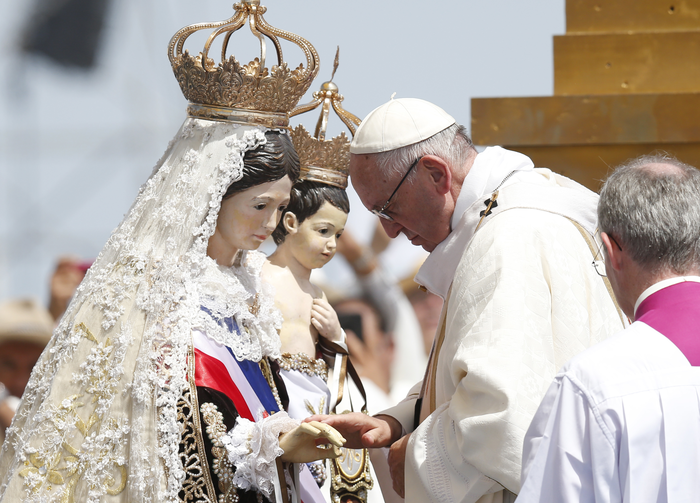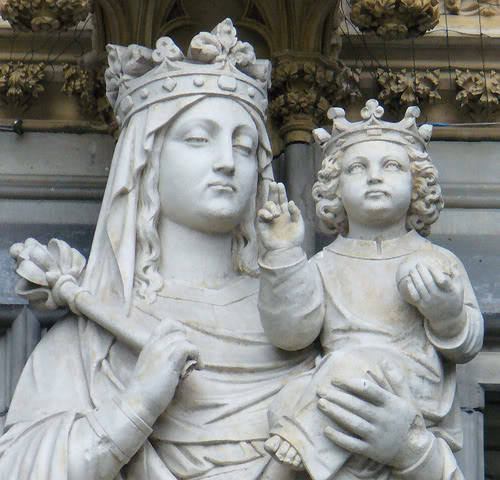In Jeremiah, the “queen of heaven” is mentioned in two places, chapter 7 and 44. To answer this question, we are going to focus on chapter 7. So, lets start with the scripture.
Do you not see what they do in the cities of Judah and in the streets of Jerusalem?
The children gather wood, and the fathers kindle the fire, and the women knead their dough, to make cakes to the queen of heaven, and to pour out drink offerings unto other gods, that they may provoke Me to anger. (cf. Jer 44:17-25)
Do they provoke Me to anger? says the Lord: do they not also provoke themselves to the confusion (shame) of their own faces?
Jeremiah 7:17-19
Notice that this worship practice which provokes God’s anger causes shame and confusion as well. Let’s see…
If you do a web search for “queen of heaven,” the first things that come up are not references to pagan goddesses, but to Mary the mother of Jesus. For example:
The Catholic teaching on this subject is expressed in the papal encyclical Ad Caeli Reginam (to the queen of heaven), issued by Pope Pius XII in 1954. It begins with this:

“From the earliest ages of the Roman Catholic church a Christian people, whether in time of triumph or more especially in time of crisis, has addressed prayers of petition and hymns of praise and veneration to the Queen of Heaven. And never has that hope wavered which they placed in the Mother of the Divine King, Jesus Christ; nor has that faith ever failed by which we are taught that Mary, the Virgin Mother of God, reigns with a mother’s solicitude over the entire world, just as she is crowned in heavenly blessedness with the glory of a Queen.”
www.vatican.va
You may be thinking, “wait, they are talking about Jesus’ mom, the “virgin” Mary, “mother of God,” not the pagan “queen of heaven” referred to in Jeremiah.” Fair enough, let’s look into these ancient worship practices that provoke God’s anger and see if they differ from those applied to the “virgin” Mary by the Catholic church.
The following information can be found in any encyclopedia on this subject.
The “queen of heaven“
A number of ancient sky goddesses worshiped throughout and around ancient Mesopotamia have been given the title of “queen of heaven”. These practices date back to at least the Bronze age and predate Christianity by thousands of years. Goddesses known to have been referred to by this title include Inanna, Anat, Isis, Samiramis, Ishtar, Astarte, Asherah, Hathor, Aphrodite, Artemis, and etc… To simplify, consider that all these names refer to the same basic pagan worship practices across many ancient cultures and times. These goddesses are worshiped not only as the “queen of heaven” but also the “mother of god.”
The pagan goddesses which are specifically referenced in the Bible are Ashera (Strong’s #842 – translated ‘groves’ in KJV losing its connection to the pagan goddess), and Ashtoreth the plural form of Astarte (Strong’s #6253).
Ashera OT:842 (ash-ay-raw’); or ‘asheyrah (ash-ay-raw’); happy; Asherah (or Astarte) a Phoenician goddess; also an image of the same: KJV – grove. Compare OT:6253.
Ashtoreth OT:6253 (ash-to’reth); Ashtoreth, the Phoenician goddess of love (and increase): KJV – Ashtoreth.
Strong’s Exhaustive Concordance
There is no difference between Astarte and Asherah. This is the chief female deity with which Israel commits idolatry, being referenced nearly 50 times from Exodus to Micah. She is worshiped as a mother goddess of fertility, sexuality, and war, identical with the goddess Ishtar, from which we get the term Easter. This is the worship practice to which Jeremiah was referring and the reason God’s wrath is kindled against Israel.
By applying these worship practices to Mary, the Roman Catholic church has continued the shame and confusion which Jeremiah warns of (Jer 7:19). They have turned the people’s hearts away from God and “provoked the LORD to anger.” That statement alone should have them shaking in their shoes.
Easter
It is no coincidence that Ishtar, one of the many goddesses called the “queen of heaven,” is phonetically identical with Easter. In Jeremiah 7:17, God specifically points to the pagan practice of “making cakes to the queen of heaven.” This baking practice has a direct connection to Easter today, known as hot cross buns.
The hot cross buns of Good Friday, and the dyed eggs of Easter Sunday, figured in the Chaldean rites just as they do now. The “buns,” known also by that identical name, were used in the worship of the queen of heaven, the goddess Easter (Ishtar), as early as … 1500 years before the Christian era.
The Two Babylons – pp. 107-108
Furthermore, the rabbits and eggs associated with Easter are obvious fertility symbols, which you would expect from a fertility goddess. It should be obvious that eggs and rabbits have nothing to do with Jesus or his mother. God was clearly referring to the worship practices of Easter in Jeremiah 7.
Sunrise Services
In a similar vein, in the book of Ezekiel, God points to Sunrise services, often observed on Easter Sunday, as an abomination.
“He said also unto me, ‘Turn yet again, and you shall see greater abominations that they do’.
Then he brought me to the door of the gate of the Lord’s house which was toward the north; and, behold, there sat women weeping for Tammuz.
Then said he unto me, Have you seen this, O son of man? turn yet again, and you shall see greater abominations than these.
And he brought me into the inner court of the Lord’s house, and, behold, at the door of the temple of the Lord, between the porch and the altar, were about five and twenty men, with their backs toward the temple of the Lord, and their faces toward the east; and they worshiped the sun toward the east.
Ezekiel 8:13-16

Tammuz, the god for which this sunrise service was being performed, is the ancient Mesopotamian god associated with shepherds. As with Ishtar, Tammuz, is just one of many names that represent the same pagan deity or doctrine. He is the pagan “god of death and resurrection”. He is called the “son of god,” and represented as a child, in the arms of the “queen of heaven.” His symbol is the tau (T), the ancient sign of the cross, the very thing that was used to murder Jesus. So, here in Ezekiel, we have women weeping for the dead son of the “queen of heaven,” the “mother of god,” during a sunrise service. Sound familiar?

“The shape of the two-beamed cross had its origin in ancient Chaldea and was used to represent the god Tammuz. Tammuz is the deified Nimrod, the first man to lead the opposition against God after the great Flood. He founded the city of Babylon, and along with his mother/wife Semiramis, founded the pagan Babylon mystery religion—the origin of all false religion today.”
the-cross-pagan-symbol-or-symbol-of-faith
Some have said that this is proof that the Christian religions have plagiarized this story, that predates Christianity, onto Jesus and his mother. However, if God refers to this as an abomination, those who have plagiarized it onto His son cannot be Christians.
In conclusion, the “queen of heaven” referred to in Jeremiah is a pagan worship practice being applied to Jesus and his mother. This is where all of the fertility symbols of the “abomination” known today as Easter come from. Furthermore, these doctrines identify the pagan organization that brought these practices into Christianity.
Makes you wonder if Pius XII ever read the book of Jeremiah. Let me reiterate, Pius XII in 1954 said “From the earliest ages of the Roman Catholic church … it has addressed prayers of petition and hymns of praise and veneration to the Queen of Heaven.” The largest “christian” organization on the face of the earth today openly admits that they venerate (worship) the “queen of heaven” and always have. The “queen” they worship has nothing to do with Heaven.
How do you think Jesus would react towards those who would worship his mother and associate her with the pagan worship practices associated with the “queen of heaven” in Jeremiah? Probably something like this:
“… Get away from me, Satan: for it is written, You shall worship the Lord your God, and Him only shall you serve.”
Matthew 4:10